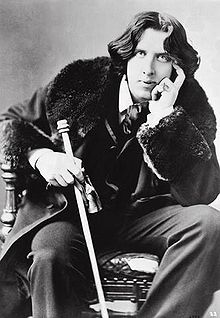The picture of Dorian Gray
Plot:
The novel is set in London at the end of the 19th century. The protagonist is Dorian Gray, a toung man whose beauty fasciantes a painter, Basil Hallward, who paints his portrait. While the young man’s desires are satisfied, including that of eternal youth, the sign of age, experiences and vices appear on the portrait. Dorian lives only for pleasure making use of everybody and letting people die because of his insensivity.
When the painter sees the corrupted image of the portrait, Dorian kills him. Later Dorian, wants to free himself of the portrait, witness to his spiritual corruption, and stabs it, but he mysteriously kills himself.
At the very moment of death the picture returns to its original purity, and Dorian’s face becomes “withered, wrinkled, and loathsome” .

Allegorical meaning:
This story is profoundly allegorical; it’s a 19th century version of the myth of Faust the story of a man who sells his soul to the devil so that all his desideres might be satisfied. This soul becomes the picture, which records the signs of experience, the corruption, the horror and the sins concealed under the mask of Dorian’s timeless beauty. Wilde plays on the Reinassance idea of the correspondence between the physical and spiritual realms: beautiful people are moral people; ugly people are immoral people. His variation on this theme is in use of the magical portrait. The picture is not an autonomous self: it stands for the dark side of Dorian’s personality, his double, which he tries to forget by locking it in a room.
The moral of this novel is that every excess must be punished and reality cannot be escaped; when Dorian destroys the picture, he cannot avoid the punishment for all his sins, that is, death.
The horribly corrupting picture and the beautiful Dorian could be symbolic of the immortality and bad coscience of the Victorian Middle Class hidden behind an appearence of innocence and outward respectability.
Victorian’s double personality: the victorian compromise.
Victorian’s values could be considered a sort of mask of the society, which hide the dark shadow of the human being as the picture of Dorian Gray done. The Victorians were great moraliser, probably because they faced numerous problems on such a scale that they felt obligated to advocate certain values which offered solution or escapes.
As the rule the values they promoted reflected not the world as they saw it, the harsh social reality around them, but the world as they would have liked it to be. Probably the most persistently advocated notion throughout the 19th Century was the need to work hard. The idea of respectability distingueshed the middle from the lower class. Respectability was a mixture of both morality and hypocrisy, severity and conformity to social standards. It implied the possession of good manners, the ownership of a confortable house with servants and a carriage, regular attendance at church, and charitable attivities. Philanthrophy was broadly-based Victorian phenomenon with a range and diversity of interests: it addressed itself to every kind of poverty, to “stay children”, “fallen women” and “drunken men” and absorbed the energies of thousands of Victorian’s, large numbers of whom where women. The concept of “fallen women” was a fate imposed upon thousands of women by a society with an intense concern for female chastity. Single women with a child suffered the worst of society’s punishments: they were ostracised.
Sexuality was generally repressed in it’s public and private forms, and moralising “ prudery” in it’s most extreme manifestations led to the denunciation of nudity in art. Patriotism was deeply influenced by ideas of racial superiority. There emerged a powerful belief that the races of the world were divided by fundamental physical and intellectual differences, that somewhere destined to be led by others. However, their self-confidence and moral certainties were only one element in a complex framework of Victorian ideals. It was, after all, an age riddled with contraddictions and doubts, notably about religion and, increasingly, about the relationship between science and belief.

